Nigel S., Chambers S., Johnson R. Operations Management
Подождите немного. Документ загружается.


plastic, and appalling colours; a construction of hardened
chewing-gum and idiot folklore taken straight out of comic
books written for obese Americans’. However, as some
commentators noted, the cultural arguments and anti-
Americanism of the French intellectual elite did not seem
to reflect the behaviour of most French people, who ‘eat
at McDonald’s, wear Gap clothing, and flock to American
movies’.
Designing Disneyland Resort Paris
Phase 1 of the Euro Disney Park was designed to have
29 rides and attractions and a championship golf course
together with many restaurants, shops, live shows and
parades as well as six hotels. Although the park was
designed to fit in with Disney’s traditional appearance and
values, a number of changes were made to accommod-
ate what was thought to be the preferences of European
visitors. For example, market research indicated that Euro-
peans would respond to a ‘wild west’ image of America.
Therefore, both rides and hotel designs were made to
emphasize this theme. Disney was also keen to diffuse
criticism, especially from French left-wing intellectuals
and politicians, that the design of the park would be too
‘Americanized’ and would become a vehicle for American
‘cultural imperialism’. To counter charges of American imper-
ialism, Disney gave the park a flavour that stressed the
European heritage of many of the Disney characters, and
increased the sense of beauty and fantasy. They were, after
all, competing against Paris’s exuberant architecture and
sights. For example, Discoveryland featured storylines from
Jules Verne, the French author. Snow White (and her dwarfs)
was located in a Bavarian village. Cinderella was located
in a French inn. Even Peter Pan was made to appear more
‘English Edwardian’ than in the original US designs.
Because of concerns about the popularity of American
‘fast food’, Euro Disney introduced more variety into its
restaurants and snack bars, featuring foods from around the
world. In a bold publicity move, Disney invited a number of
top Paris chefs to visit and taste the food. Some anxiety was
also expressed concerning the different ‘eating behaviour’
between Americans and Europeans. Whereas Americans
preferred to ‘graze’, eating snacks and fast meals through-
out the day, Europeans generally preferred to sit down and
eat at traditional meal times. This would have a very signi-
ficant impact on peak demand levels on dining facilities.
A further concern was that in Europe (especially French)
visitors would be intolerant of long queues. To overcome
this, extra diversions such as films and entertainments
were planned for visitors as they waited in line for a ride.
Before the opening of the park, Euro Disney had to
recruit and train between 12,000 and 14,000 permanent
and around 5,000 temporary employees. All these new
employees were required to undergo extensive training in
order to prepare them to achieve Disney’s high standard
of customer service as well as understand operational
routines and safety procedures. Originally, the company’s
objective was to hire 45 per cent of its employees from
France, 30 per cent from other European countries, and
15 per cent from outside of Europe. However, this proved
difficult and when the park opened around 70 per cent
of employees were French. Most cast members were paid
around 15 per cent above the French minimum wage.
An information centre was opened in December 1990
to show the public what Disney was constructing. The
‘casting centre’ was opened on 1 September 1991 to
recruit the ‘cast members’ needed to staff the park’s
attractions. But the hiring process did not go smoothly. In
particular, Disney’s grooming requirements that insisted
on a ‘neat’ dress code, a ban on facial hair, set standards
for hair and finger nails, and an insistence on ‘appropriate
undergarments’ proved controversial. Both the French
press and trade unions strongly objected to the grooming
requirements, claiming they were excessive and much
stricter than was generally held to be reasonable in France.
Nevertheless, the company refused to modify its groom-
ing standards. Accommodating staff also proved to be
a problem, when the large influx of employees swamped
the available housing in the area. Disney had to build its
own apartments as well as rent rooms in local homes just
to accommodate its employees. Notwithstanding all the
difficulties, Disney did succeed in recruiting and training all
its cast members before the opening.
The park opens
The park opened to employees, for testing during late
March 1992, during which time the main sponsors and their
families were invited to visit the new park, but the opening
was not helped by strikes on the commuter trains lead-
ing to the park, staff unrest, threatened security problems
(a terrorist bomb had exploded the night before the
opening) and protests in surrounding villages that demon-
strated against the noise and disruption from the park.
The opening day crowds, expected to be 500,000, failed
to materialize, however, and at close of the first day only
50,000 people had passed through the gates. Disney had
expected the French to make up a larger proportion of
visiting guests than they did in the early days. This may
have been partly due to protests from French locals who
feared their culture would be damaged by Euro Disney.
Also, all Disney parks had traditionally been alcohol-free.
To begin with, Euro Disney was no different. However, this
was extremely unpopular, particularly with French visitors
who like to have a glass of wine or beer with their food.
But whatever the cause the low initial attendance was very
disappointing for the Disney Company.
It was reported that, in the first 9 weeks of operation,
approximately 1,000 employees left Euro Disney, about
one half of whom ‘left voluntarily’. The reasons cited for
leaving varied. Some blamed the hectic pace of work and
the long hours that Disney expected. Others mentioned
the ‘chaotic’ conditions in the first few weeks. Even Disney
conceded that conditions had been tough immediately after
Part Two Design
164
M06A_SLAC0460_06_SE_C06A.QXD 10/20/09 9:27 Page 164

the park opened. Some leavers blamed Disney’s apparent
difficulty in understanding ‘how Europeans work’. ‘We can’t
just be told what to do, we ask questions and don’t all
think the same.’ Some visitors who had experience of the
American parks commented that the standards of service
were noticeably below what would be acceptable in
America. There were reports that some cast members were
failing to meet Disney’s normal service standard: ‘even on
the opening weekend some clearly couldn’t care less . . .
My overwhelming impression . . . was that they were out of
their depth. There is much more to being a cast member
than endlessly saying “Bonjour”. Apart from having a
detailed knowledge of the site, Euro Disney staff have the
anxiety of not knowing in what language they are going to
be addressed . . . Many were struggling.’
It was also noticeable that different nationalities
exhibited different types of behaviour when visiting the
park. Some nationalities always used the waste bins while
others were more likely to drop litter on the floor. Most
noticeable were differences in queuing behaviour. Northern
Europeans tend to be disciplined and content to wait for
rides in an orderly manner. By contrast some Southern
European visitors ‘seem to have made an Olympic event
out of getting to the ticket taker first’. Nevertheless, not all
reactions were negative. European newspapers also
quoted plenty of positive reaction from visitors, especially
children. Euro Disney was so different from the existing
European theme parks, with immediately recognizable
characters and a wide variety of attractions. Families who
could not afford to travel to the United States could now
interact with Disney characters and ‘sample the experi-
ence at far less cost’.
The next 15 years
By August 1992 estimates of annual attendance figures were
being drastically cut from 11 million to just over 9 million.
EuroDisney’s misfortunes were further compounded in
late 1992 when a European recession caused property
prices to drop sharply, and interest payments on the large
start-up loans taken out by EuroDisney forced the com-
pany to admit serious financial difficulties. Also the cheap
dollar resulted in more people taking their holidays in
Florida at Walt Disney World. At the first anniversary of
the park’s opening, in April 1993, Sleeping Beauty’s Castle
was decorated as a giant birthday cake to celebrate the
occasion; however, further problems were approaching.
Criticized for having too few rides, the roller coaster ‘Indiana
Jones and the Temple of Peril’ was opened in July. This was
the first Disney roller coaster that included a 360-degree
loop, but just a few weeks after opening emergency brakes
locked on during a ride, causing some guest injuries. The
ride was temporarily shut down for investigations. Also in
1993 the proposed Euro Disney phase 2 was shelved due
to financial problems. This meant Disney MGM Studios
Europe and 13,000 hotel rooms would not be built to the
original 1995 deadline originally agreed upon by the Walt
Disney Company. However, Discovery Mountain, one of
the planned phase 2 attractions, did get approval.
By the start of 1994 rumours were circulating that the
park was on the verge of bankruptcy. Emergency crisis
talks were held between the banks and backers with things
coming to a head during March when Disney offered the
banks an ultimatum. It would provide sufficient capital for
the park to continue to operate until the end of the month,
but unless the banks agreed to restructure the park’s $1bn
debt, the Walt Disney Company would close the park, and
walk away from the whole European venture, leaving the
banks with a bankrupt theme park and a massive expanse
of virtually worthless real estate. Michael Eisner, Disney’s
CEO, announced that Disney was planning to pull the plug
on the venture at the end of March 1994 unless the banks
were prepared to restructure the loans. The banks agreed
to Disney’s demands.
In May 1994 the connection between London and Marne
La Vallée was completed, along with a TGV link, providing
a connection between several major European cities. By
August the park was starting to find its feet at last, and
all of the park’s hotels were fully booked during the peak
holiday season. Also, in October, the park’s name was
officially changed from EuroDisney to ‘Disneyland Paris’
in order to ‘show that the resort now was named much
more like its counterparts in California and Tokyo’. The
end-of-year figures for 1994 showed encouraging signs
despite a 10% fall in attendance caused by the bad publicity
over the earlier financial problems. For the next few years
new rides continued to be introduced. 1995 saw the opening
of the new roller coaster, ‘Space Mountain de la Terre à
la Lune’, and Euro Disney did announce its first annual
operating profit in November 1995. New attractions were
added steadily, but in 1999 the planned Christmas and
New Year celebrations are disrupted when a freak storm
caused havoc, destroying the Mickey Mouse glass statue
that had just been installed for the Lighting Ceremony and
many other attractions.
Disney’s ‘Fastpass’ system was introduced in 2000: a
new service that allowed guests to use their entry passes
to gain a ticket at certain attractions and return at the
time stated and gain direct entry to the attraction without
queuing. Two new attractions were also opened, ‘Indiana
Jones et la Temple du Peril’ and ‘Tarzan le Recontre’
starring a cast of acrobats along with Tarzan, Jane and all
their jungle friends with music from the movie in different
European languages. In 2001 the ‘ImagiNations Parade’ is
replaced by the ‘Wonderful World of Disney Parade’ which
receives some criticism for being ‘less than spectacular’ with
only 8 parade floats. Also Disney’s ‘California Adventure’
was opened in California. The Paris resort’s 10th anniver-
sary saw the opening of the new Walt Disney Studios Park
attraction, based on a similar attraction in Florida that had
already proved to be a success.
André Lacroix from Burger King was appointed as CEO
of Disneyland Resort Paris in 2003, to ‘take on the challenge
Chapter 6 Supply network design
165
➔
M06A_SLAC0460_06_SE_C06A.QXD 10/20/09 9:27 Page 165
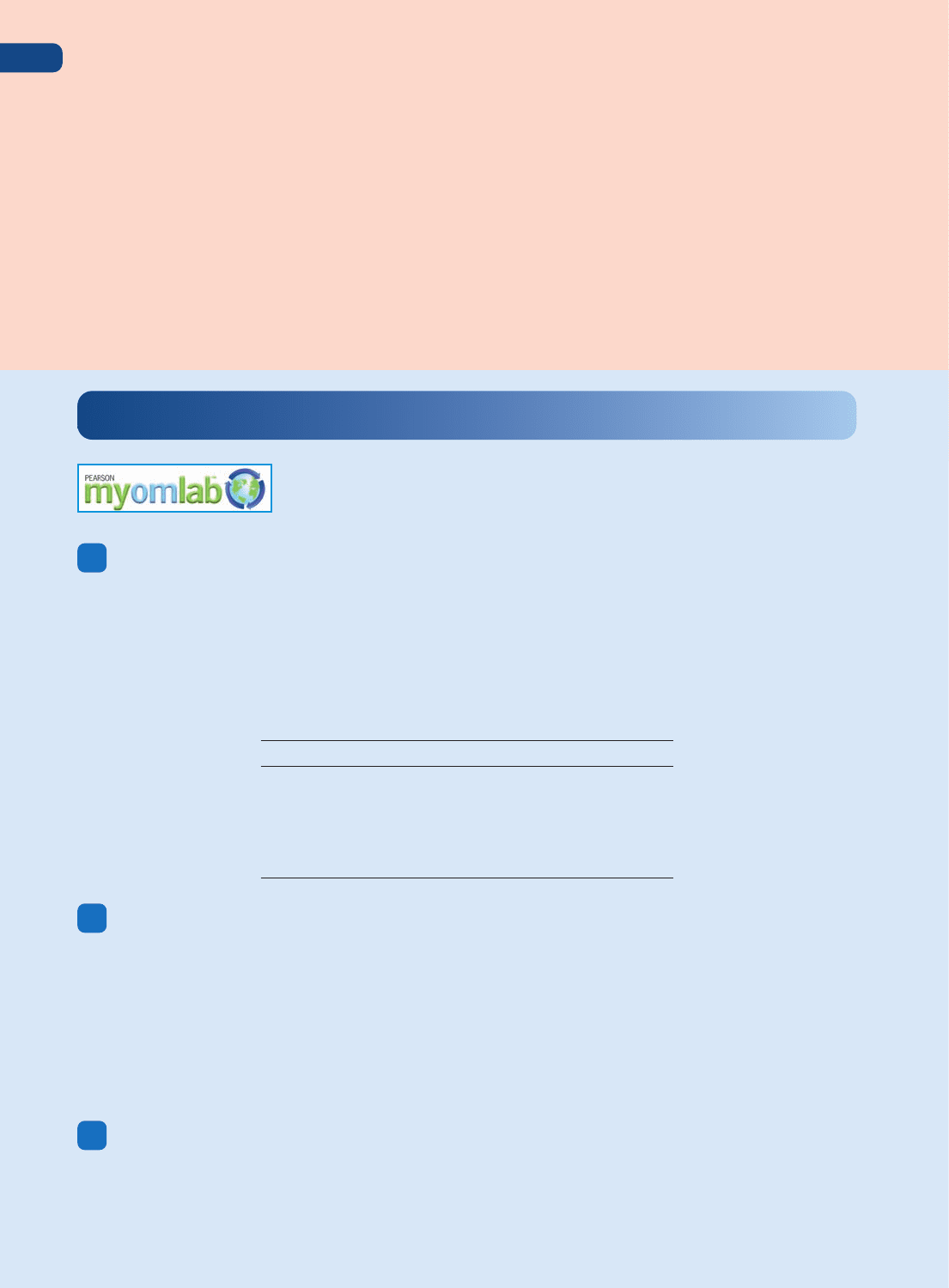
of a failing Disney park in Europe and turn it around’.
Increasing investment, he refurbished whole sections of the
park and introduced the Jungle Book Carnival in February
to increase attendance during the slow months. By 2004
attendance had increased but the company announced
that it was still losing money. And even the positive news
of 2006, although generally well received still left questions
unanswered. As one commentator put it, ‘Would Disney,
the stockholders, the banks, or even the French government
make the same decision to go ahead if they could wind
the clock back to 1987? Is this a story of a fundamentally
flawed concept, or was it just mishandled?’
Questions
1 What markets are the Disney resorts and parks
aiming for?
2 Was Disney’s choice of the Paris site a mistake?
3 What aspects of their parks’ design did Disney change
when it constructed Euro Disney?
4 What did Disney not change when it constructed
Euro Disney?
5 What were Disney’s main mistakes from the
conception of the Paris resort through to 2006?
Part Two Design
166
These problems and applications will help to improve your analysis of operations. You
can find more practice problems as well as worked examples and guided solutions on
MyOMLab at
www.myomlab.com.
A company is deciding between two locations (Location A and Location B). It has six location criteria, the
most important being the suitability of the buildings that are available in each location. About half as important
as the suitability of the buildings are the access to the site and the supply of skills available locally. Half as
important as these two factors are the potential for expansion on the sites and the attractiveness of the area.
The attractiveness of the buildings themselves is also a factor, although a relatively unimportant one, rating
one half as important as the attractiveness of the area. Table 6.7 indicates the scores for each of these factors,
as judged by the company’s senior management. What would you advise the company to do?
1
A company which assembles garden furniture obtains its components from three suppliers. Supplier A provides
all the boxes and packaging material; supplier B provides all metal components; and supplier C provides all
plastic components. Supplier A sends one truckload of the materials per week to the factory and is located
at the position (1,1) on a grid reference which covers the local area. Supplier B sends four truckloads of
components per week to the factory and is located at point (2,3) on the grid. Supplier C sends three truckloads
of components per week to the factory and is located at point (4,3) on the grid. After assembly, all the products
are sent to a warehouse which is located at point (5,1) on the grid. Assuming there is little or no waste
generated in the process, where should the company locate its factory so as to minimize transportation costs?
Assume that transportation costs are directly proportional to the number of truckloads of parts, or finished
goods, transported per week.
A rapid-response maintenance company serves its customers who are located in four industrial estates. Estate A has
15 customers and is located at grid reference (5,7). Estate B has 20 customers and is located at grid reference
(6,3). Estate C has 15 customers and is located at grid reference (10,2) but these customers are twice as likely
to require service as the company’s other customers. Estate D has 10 customers and is located at grid reference
(12,3). At what grid reference should the company be looking to find a suitable location for its service centre?
3
2
Table 6.7 The scores for each factor in the location decision
as judged by the company’s senior management
Location A Location B
Access 4 6
Expansion 6 5
Attractiveness (area) 10 6
Skills supply 5 7
Suitability of buildings 8 7
Attractiveness of buildings 4 6
Problems and applications
M06A_SLAC0460_06_SE_C06A.QXD 10/20/09 9:27 Page 166
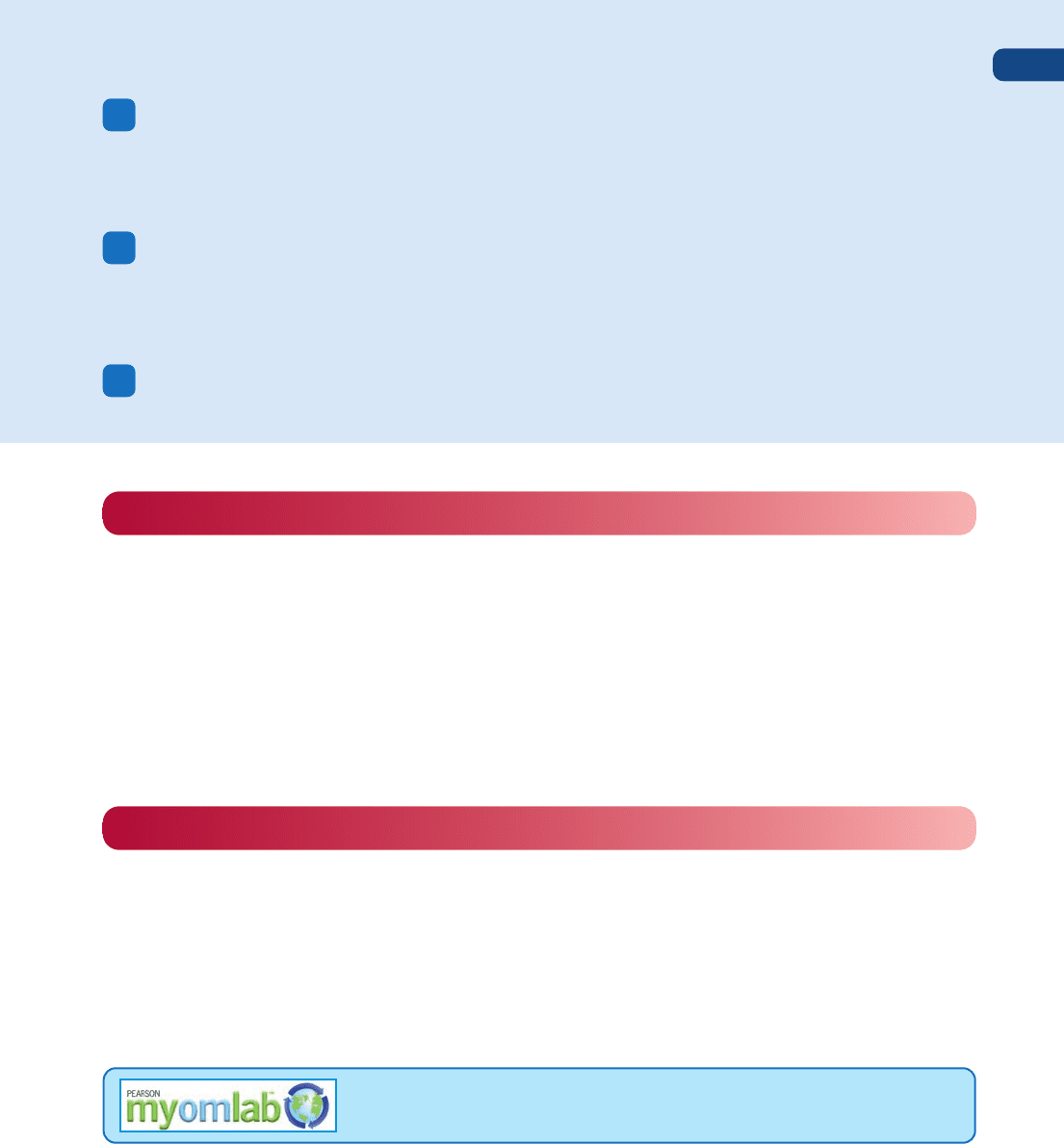
A private health-care clinic has been offered a leasing deal where it could lease a CAT scanner at a fixed
charge of A2,000 per month and a charge per patient of A6 per patient scanned. The clinic currently charges
A10 per patient for taking a scan. (a) At what level of demand (in number of patients per week) will the clinic
break even on the cost of leasing the CAT scan? (b) Would a revised lease that stipulated a fixed cost of
A3,000 per week and a variable cost of A0.2 per patient be a better deal?
Visit sites on the Internet that offer (legal) downloadable music using MP3 or other compression formats.
Consider the music business supply chain, (a) for the recordings of a well-known popular music artist, and
(b) for a less well-known (or even largely unknown) artist struggling to gain recognition. How might the
transmission of music over the Internet affect each of these artists’ sales? What implications does electronic
music transmission have for record shops?
Visit the web sites of companies that are in the paper manufacturing/pulp production/packaging industries.
Assess the extent to which the companies you have investigated are vertically integrated in the paper supply
chain that stretches from foresting through to the production of packaging materials.
6
5
4
Chapter 6 Supply network design
167
Carmel, E. and Tjia, P. (2005) Offshoring Information
Technology: Sourcing and Outsourcing to a Global Workforce,
Cambridge University Press, Cambridge. An academic book
on outsourcing.
Chopra, S. and Meindl, P. (2001) Supply Chain Management:
Strategy, Planning and Operations, Prentice Hall, Upper
Saddle River, NJ. A good textbook that covers both strategic
and operations issues.
Dell, M. (with Catherine Fredman) (1999) Direct from Dell:
Strategies that Revolutionized an Industry, Harper Business
London. Michael Dell explains how his supply network
strategy (and other decisions) had such an impact on the
industry. Interesting and readable, but not a critical analysis!
Schniederjans, M.J. (1998) International Facility Location
and Acquisition Analysis, Quorum Books, New York. Very
much one for the technically minded.
Vashistha, A. and Vashistha, A. (2006) The Offshore Nation:
Strategies for Success in Global Outsourcing and Offshoring,
McGraw-Hill Higher Education. Another topical book on
outsourcing.
Selected further reading
www.locationstrategies.com Exactly what the title implies.
Good industry discussion.
www.cpmway.com American location selection site. You can
get a flavour of how location decisions are made.
www.transparency.org A leading site for international busi-
ness (including location) that fights corruption.
www.intel.com More details on Intel’s ‘Copy Exactly’ strategy
and other capacity strategy issues.
www.opsman.org Lots of useful stuff.
www.outsourcing.com Site of the Institute of Outsourcing.
Some good case studies and some interesting reports, news
items, etc.
www.bath.ac.uk/crisps A centre for research in strategic pur-
chasing and supply with some interesting papers.
Useful web sites
Now that you have finished reading this chapter, why not visit MyOMLab at
www.myomlab.com where you’ll find more learning resources to help you
make the most of your studies and get a better grade?
M06A_SLAC0460_06_SE_C06A.QXD 10/20/09 9:27 Page 167

Supplement to
Chapter 6
Forecasting
Introduction
Some forecasts are accurate. We know exactly what time the sun will rise at any given
place on earth tomorrow or one day next month or even next year. Forecasting in a business
context, however, is much more difficult and therefore prone to error. We do not know
precisely how many orders we will receive or how many customers will walk through the
door tomorrow, next month, or next year. Such forecasts, however, are necessary to help
managers make decisions about resourcing the organization for the future.
Forecasting – knowing the options
Simply knowing that demand for your goods or services is rising or falling is not enough in
itself. Knowing the rate of change is likely to be vital to business planning. A firm of lawyers
may have to decide the point at which, in their growing business, they will have to take
on another partner. Hiring a new partner could take months so they need to be able to fore-
cast when they expect to reach that point and then when they need to start their recruitment
drive. The same applies to a plant manager who will need to purchase new plant to deal with
rising demand. She may not want to commit to buying an expensive piece of machinery until
absolutely necessary but in enough time to order the machine and have it built, delivered,
installed and tested. The same is so for governments whether planning new airports or
runway capacity or deciding where and how many primary schools to build.
The first question is to know how far you need to look ahead and this will depend on
the options and decisions available to you. Take the example of a local government where the
number of primary-age children (5–11-year-olds) is increasing in some areas and declining
in other areas within its boundaries. It is legally obliged to provide school places for all such
children. Government officials will have a number of options open to them and they may
each have different lead times associated with them. One key step in forecasting is to know
the possible options and the lead times required to bring them about (see Table S6.1).
Table S6.1 Options available and lead time required for
dealing with changes in numbers of schoolchildren
Options available Lead time required
Hire short-term teachers Hours
Hire staff
Build temporary classrooms
Amend school catchment areas
Build new classrooms
Build new schools Years
M06B_SLAC0460_06_SE_C06B.QXD 10/21/09 13:39 Page 168
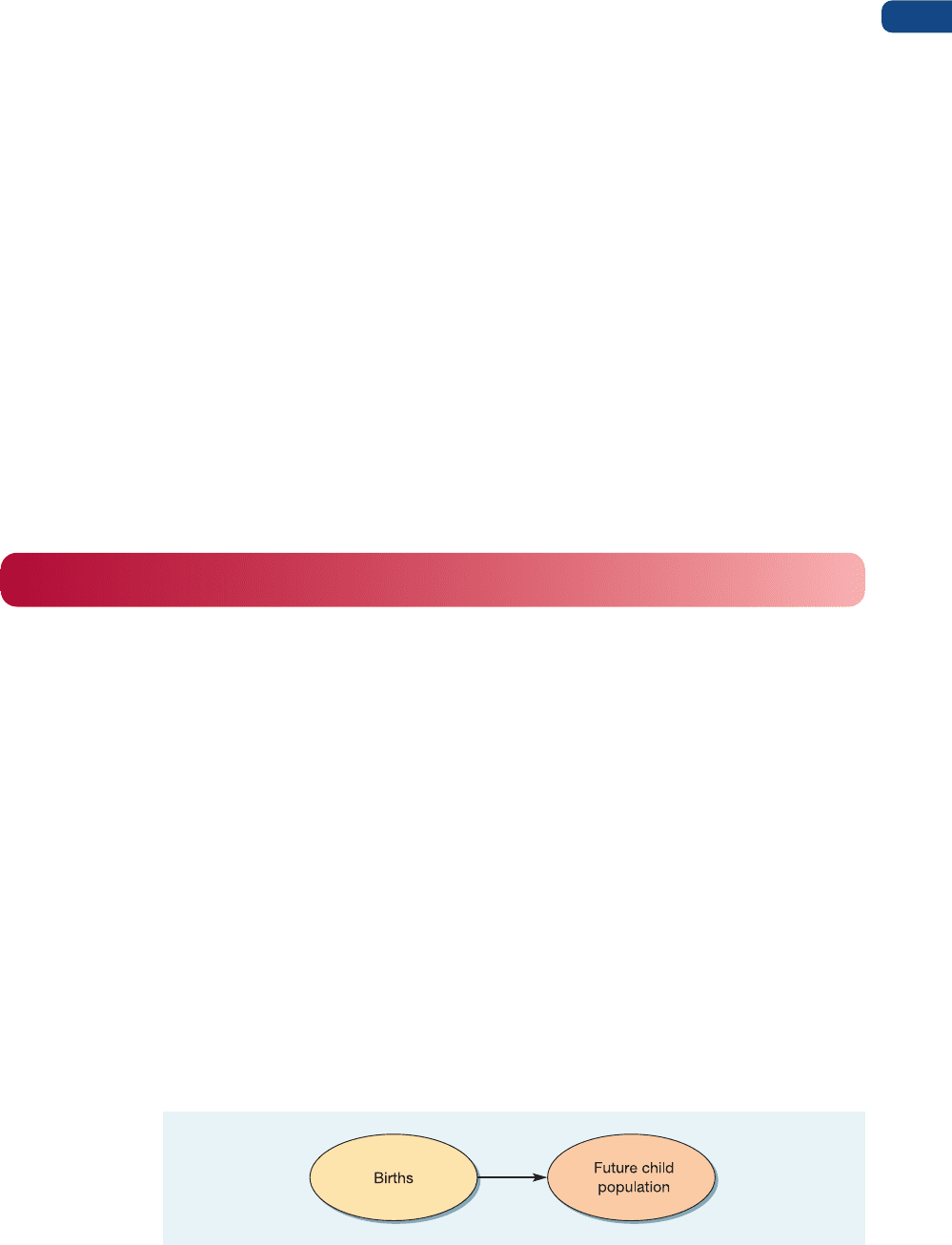
Supplement to Chapter 6 Forecasting
169
Figure S6.1 Simple prediction of future child population
1 Individual schools can hire (or lay off ) short-term (supply) teachers from a pool not only
to cover for absent teachers but also to provide short-term capacity while teachers are
hired to deal with increases in demand. Acquiring (or dismissing) such temporary cover
may only require a few hours’ notice. (This is often referred to as short-term capacity
management.)
2 Hiring new (or laying off existing) staff is another option but both of these may take months
to complete. (Medium-term capacity management.)
3 A shortage of accommodation may be fixed in the short to medium term by hiring or
buying temporary classrooms. It may only take a couple of weeks to hire such a building
and equip it ready for use.
4 It may be possible to amend catchment areas between schools to try to balance an increas-
ing population in one area against a declining population in another. Such changes may
require lengthy consultation processes.
5 In the longer term new classrooms or even new schools may have to be built. The planning,
consultation, approval, commissioning, tendering, building and equipping process may
take 1 to 5 years depending on the scale of the new build. (Long-term capacity planning –
see Chapter 6.)
Knowing the range of options managers can then decide the timescale for their forecasts;
indeed several forecasts might be needed for the short term, medium term and long term.
In essence forecasting is simple
In essence forecasting is easy. To know how many children may turn up in a local school
tomorrow you can use the number that turned up today. In the long term in order to fore-
cast how many primary-aged children will turn up at a school in five years’ time one need
simply look at the birth statistics for the current year for the school’s catchment area, see
Figure S6.1.
However, such simple extrapolation techniques are prone to error and indeed such approaches
have resulted in some local governments committing themselves to building schools which 5
or 6 years later, when complete, had few children and other schools bursting at the seams with
temporary classrooms and temporary teachers, often resulting in falling morale and declining
educational standards. The reason why such simple approaches are prone to problems is that
there are many contextual variables (see Figure S6.2) which will have a potentially significant
impact on, for example, the school population five years hence. For example:
1 One minor factor in developed countries, though a major factor in developing countries,
might be the death rate in children between birth and 5 years of age. This may be depend-
ent upon location with a slightly higher mortality rate in the poorer areas compared to the
more affluent areas.
2 Another more significant factor is immigration and emigration as people move into or
out of the local area. This will be affected by housing stock and housing developments and
the ebb and flow of jobs in the area and the changing economic prosperity in the area.
M06B_SLAC0460_06_SE_C06B.QXD 10/21/09 13:39 Page 169
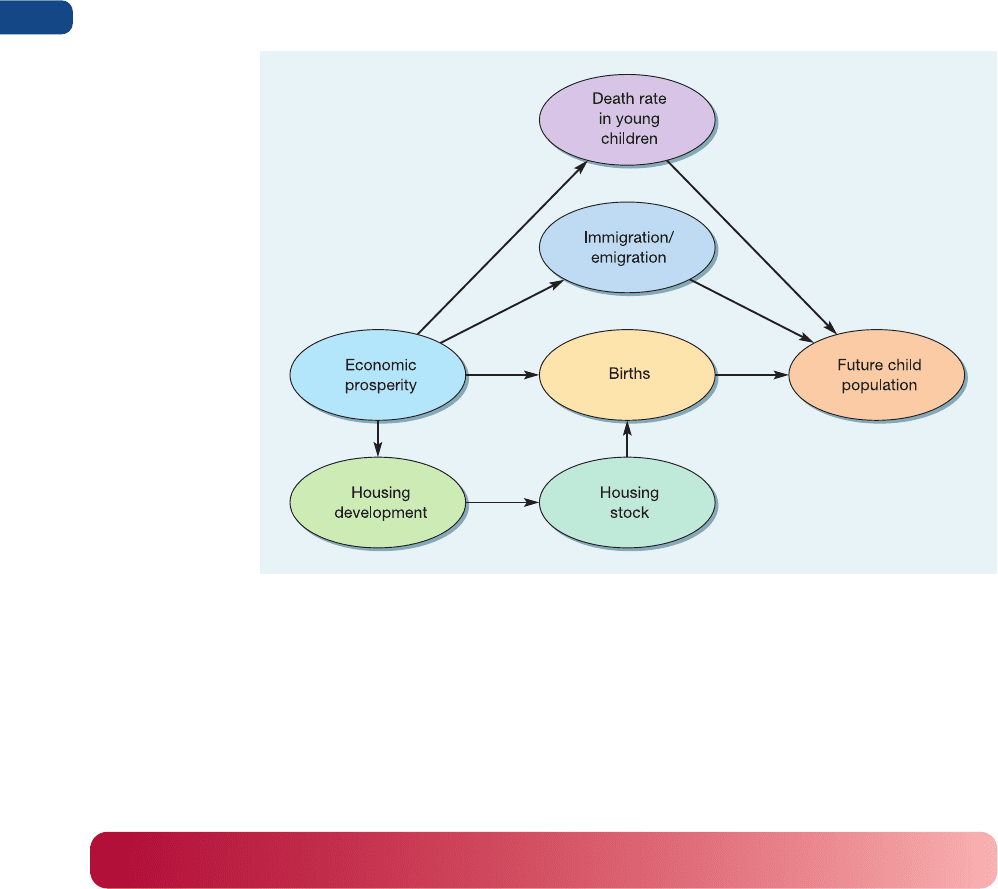
Part Two Design
170
Figure S6.2 Some of the key causal variables in predicting child populations
3 One key factor which has an impact on the birth rate in an area is the amount and type
of the housing stock. City-centre tenement buildings tend to have a higher proportion of
children per dwelling, for example, than suburban semi-detached houses. So, not only will
existing housing stock have an impact on the child population but so also will the type of
housing developments under construction, planned and proposed.
Approaches to forecasting
There are two main approaches to forecasting. Managers sometimes use qualitative methods
based on opinions, past experience and even best guesses. There is also a range of qualitative
forecasting techniques available to help managers evaluate trends and causal relationships
and make predictions about the future. Also, quantitative forecasting techniques can be used
to model data. Although no approach or technique will result in an accurate forecast a com-
bination of qualitative and quantitative approaches can be used to great effect by bringing
together expert judgements and predictive models.
Qualitative methods
Imagine you were asked to forecast the outcome of a forthcoming football match. Simply
looking at the teams’ performance over the last few weeks and extrapolating it is unlikely to
yield the right result. Like many business decisions the outcome will depend on many other
factors. In this case the strength of the opposition, their recent form, injuries to players on
both sides, the match location and even the weather will have an influence on the outcome.
A qualitative approach involves collecting and appraising judgements, options, even best guesses
as well as past performance from ‘experts’ to make a prediction. There are several ways this
can be done: a panel approach, the Delphi method and scenario planning.
Qualitative forecasting
Quantitative forecasting
M06B_SLAC0460_06_SE_C06B.QXD 10/21/09 13:39 Page 170

Panel approach
Just as panels of football pundits gather to speculate about likely outcomes so too do politicians,
business leaders, stock market analysts, banks and airlines. The panel acts like a focus group
allowing everyone to talk openly and freely. Although there is the great advantage of several
brains being better than one, it can be difficult to reach a consensus, or sometimes the views
of the loudest or highest status may emerge (the bandwagon effect). Although more reliable
than one person’s views the panel approach still has the weakness that everybody, even the
experts, can get it wrong.
Delphi method
Perhaps the best-known approach to generating forecasts using experts is the Delphi method.
This is a more formal method which attempts to reduce the influences from procedures
of face-to-face meetings. It employs a questionnaire, e-mailed or posted to the experts. The
replies are analysed and summarized and returned, anonymously, to all the experts. The
experts are then asked to re-consider their original response in the light of the replies and
arguments put forward by the other experts. This process is repeated several more times to
conclude with either a consensus or at least a narrower range of decisions. One refinement
of this approach is to allocate weights to the individuals and their suggestions based on,
for example, their experience, their past success in forecasting, other people’s views of their
abilities. The obvious problems associated with this method include constructing an appro-
priate questionnaire, selecting an appropriate panel of experts and trying to deal with their
inherent biases.
1
Scenario planning
One method for dealing with situations of even greater uncertainty is scenario planning.
This is usually applied to long-range forecasting, again using a panel. The panel members
are usually asked to devise a range of future scenarios. Each scenario can then be discussed
and the inherent risks considered. Unlike the Delphi method scenario planning is not neces-
sarily concerned with arriving at a consensus but looking at the possible range of options
and putting plans in place to try to avoid the ones that are least desired and taking action to
follow the most desired.
Quantitative methods
There are two main approaches to qualitative forecasting, time series analysis and causal
modelling techniques.
Time series examine the pattern of past behaviour of a single phenomenon over time
taking into account reasons for variation in the trend in order to use the analysis to forecast
the phenomenon’s future behaviour.
Causal modelling is an approach which describes and evaluates the complex cause–effect
relationships between the key variables (such as in Figure S6.2).
Time series analysis
Simple time series plot a variable over time by removing underlying variations with assign-
able causes use extrapolation techniques to predict future behaviour. The key weakness with
this approach is that it simply looks at past behaviour to predict the future ignoring causal
variables which are taken into account in other methods such as causal modelling or qualita-
tive techniques. For example, suppose a company is attempting to predict the future sales of
a product. The past three years’ sales, quarter by quarter, are shown in Figure S6.3(a). This
series of past sales may be analysed to indicate future sales. For instance, underlying the series
might be a linear upward trend in sales. If this is taken out of the data, as in Figure S6.3(b),
we are left with a cyclical seasonal variation. The mean deviation of each quarter from the
trend line can now be taken out, to give the average seasonality deviation. What remains is
Supplement to Chapter 6 Forecasting
171
Delphi methods
Scenario planning
Time series analysis
Causal modelling
M06B_SLAC0460_06_SE_C06B.QXD 10/21/09 13:39 Page 171
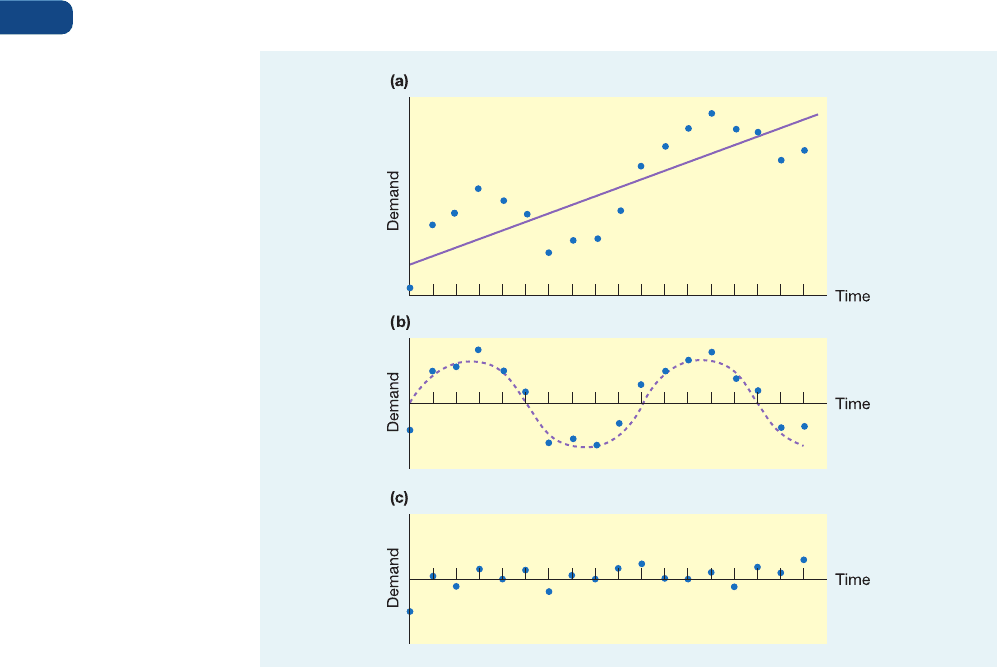
the random variation about the trends and seasonality lines, Figure S6.3(c). Future sales may
now be predicted as lying within a band about a projection of the trend, plus the seasonality.
The width of the band will be a function of the degree of random variation.
Forecasting unassignable variations
The random variations which remain after taking out trend and seasonal effects are without
any known or assignable cause. This does not mean that they do not have a cause, however,
but just that we do not know what it is. Nevertheless, some attempt can be made to forecast
it, if only on the basis that future events will, in some way, be based on past events. We will
examine two of the more common approaches to forecasting which are based on projecting
forward from past behaviour. These are:
● moving-average forecasting;
● exponentially smoothed forecasting.
Moving-average forecasting
The moving-average approach to forecasting takes the previous n periods’ actual demand
figures, calculates the average demand over the n periods, and uses this average as a forecast
for the next period’s demand. Any data older than the n periods plays no part in the next
period’s forecast. The value of n can be set at any level, but is usually in the range 4 to 7.
Example – Eurospeed parcels
Table S6.2 shows the weekly demand for Eurospeed, a Europe-wide parcel delivery company.
It measures demand, on a weekly basis, in terms of the number of parcels which it is given
to deliver (irrespective of the size of each parcel). Each week, the next week’s demand is
Moving-average
forecasting
Exponentially smoothed
forecasting
Part Two Design
172
Figure S6.3 Time series analysis with (a) trend, (b) seasonality and (c) random variation
M06B_SLAC0460_06_SE_C06B.QXD 10/21/09 13:39 Page 172
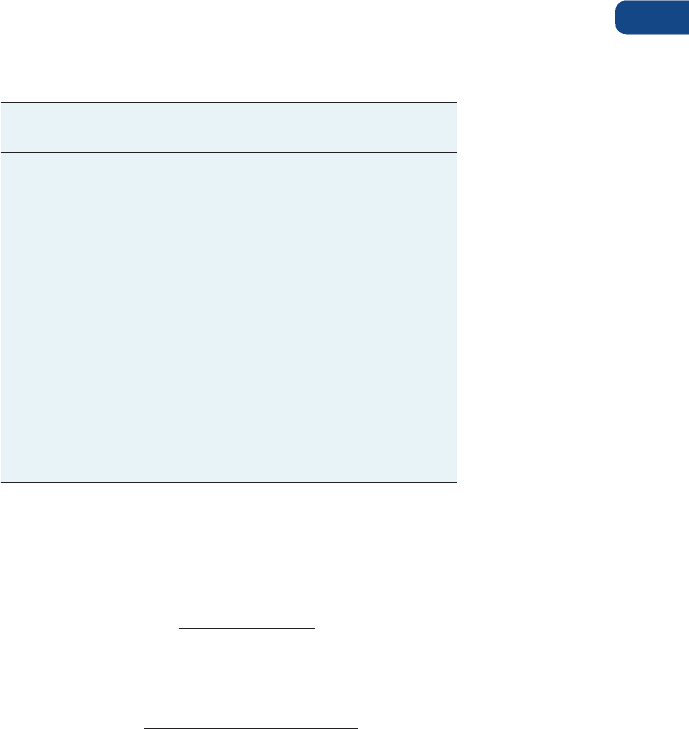
Supplement to Chapter 6 Forecasting
173
Table S6.2 Moving-average forecast calculated over a
four-week period
Week Actual demand Forecast
(thousands)
20 63.3
21 62.5
22 67.8
23 66.0
24 67.2 64.9
25 69.9 65.9
26 65.6 67.7
27 71.1 66.3
28 68.8 67.3
29 68.4 68.9
30 70.3 68.5
31 72.5 69.7
32 66.7 70.0
33 68.3 69.5
34 67.0 69.5
35 68.6
forecast by taking the moving average of the previous four weeks’ actual demand. Thus if the
forecast demand for week t is F
t
and the actual demand for week t is A
t
, then
F
t
=
For example, the forecast for week 35:
F
35
=
= 68.6
Exponential smoothing
There are two significant drawbacks to the moving-average approach to forecasting. First,
in its basic form, it gives equal weight to all the previous n periods which are used in the
calculations (although this can be overcome by assigning different weights to each of the n
periods). Second, and more important, it does not use data from beyond the n periods over
which the moving average is calculated. Both these problems are overcome by exponential
smoothing, which is also somewhat easier to calculate. The exponential smoothing approach
forecasts demand in the next period by taking into account the actual demand in the current
period and the forecast which was previously made for the current period. It does so accord-
ing to the formula
F
t
= α A
t− 1
+ (1 − x)F
t− 1
where α = the smoothing constant.
The smoothing constant α is, in effect, the weight which is given to the last (and therefore
assumed to be most important) piece of information available to the forecaster. However,
the other expression in the formula includes the forecast for the current period which
included the previous period’s actual demand, and so on. In this way all previous data has a
(diminishing) effect on the next forecast.
Table S6.3 shows the data for Eurospeed’s parcels forecasts using this exponential smooth-
ing method, where α = 0.2. For example, the forecast for week 35 is:
F
35
= 0.2 × 67.0 + 0.8 × 68.3 = 68.04
(72.5 + 66.7 + 68.3 + 67.0)
4
A
t− 2
+ A
t− 3
+ A
t− 4
4
M06B_SLAC0460_06_SE_C06B.QXD 10/21/09 13:39 Page 173
